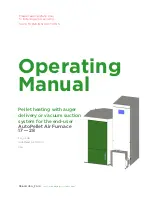
Flue gas system
13
5.4 Flue gas system
The flue gas system consists of a chimney and a flue gas tube. The flue gas tube connects the pellet heating
system to the chimney. The chimney leads the flue gas from the pellet heating system out into the open.
1.
Design of the chimney
The dimensions and design of the chimney is very important. The chimney must be able to ensure suffici-
ent draft to safely draw away the flue gas regardless of the status of the Furnace. Low flue gas temperatu-
res can cause sooting and moisture damage on chimneys that are not insulated. For this reason
moisture-
resistant chimneys
(stainless steel or ceramic) should be used. An existing chimney that is not damp-re-
sistant needs to be rennovated before use. Follow guidelines below:
Furnace size
Furnace
Flue gas tube diameter (at Furnace)
inch/mm
6.3/160
Flue gas temp. / rated power
°F
Flue gas temp. / partial load
°F
Min. draft – full load/part load
in/wc
– 0.04 / – 0.02
Chimney size
Min. Height
6in x 6in
17ft
7in x 7in
16ft
8in x 8in
16ft
6in round
19ft
7in round
17ft
Person(s) operating a pellet fired furnace is/are respon-
sible for operation in a manner that does not create a
public or private nuisance condition. The manufacturer's
distance and stack height recommendations and the re-
quirements in any applicable laws or other requirements
may not always be adequate to prevent nuisance condi-
tions due to terrain or other factors.
Recommended and UL-103HT approved chimney materials are:
a.
Selkirk sure temp
b. Supervent (JSC)
c.
Security chimneys (secure temp ASHT)
Use flue gas pipe from chimney to Furnace as required by your local code.
U
Un
nrre
eg
gu
ulla
atte
ed
d c
co
om
mb
bu
ussttiio
on
n
Please observe that combustion air openings and flue
pipes are not reduced in size or closed. Make end user
aware of these guidelines and their potential danger.
Clean the chimney and the flue gas tube at regular
intervals.
Check if the draft inducer is clean and in a good
condition.
Operating Manual AutoPellet Air Furnace 17 — 28














































